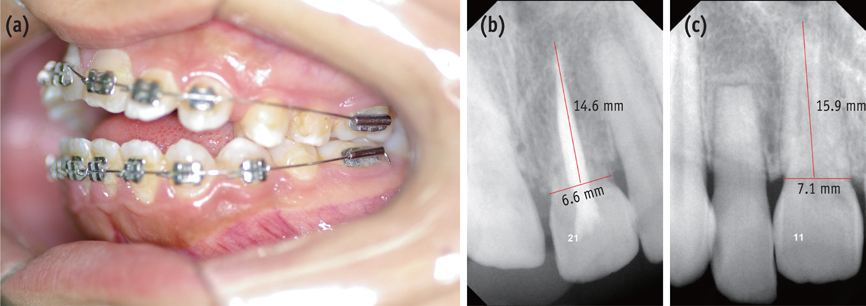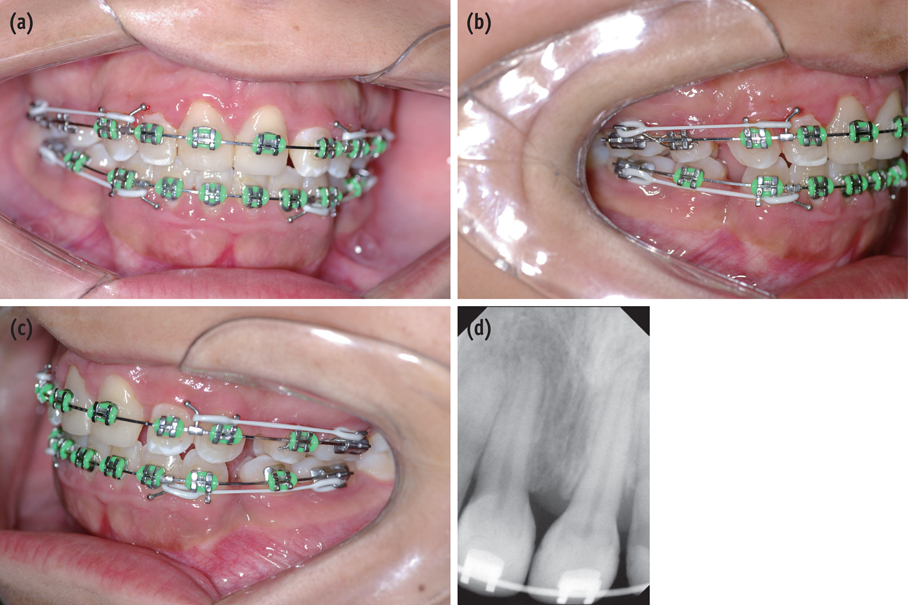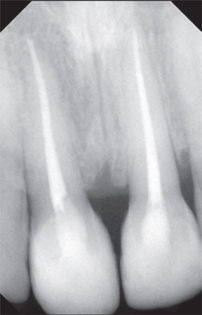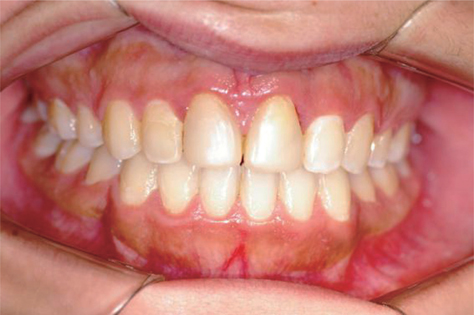Restor Dent Endod.
2015 Aug;40(3):236-240. 10.5395/rde.2015.40.3.236.
Autotransplantation combined with orthodontic treatment: a case involving the maxillary central incisors with root resorption after traumatic injury
- Affiliations
-
- 1Faculty of Medicine, University of Coimbra, Coimbra, Portugal. mmferreira@fmed.uc.pt
- KMID: 2396468
- DOI: http://doi.org/10.5395/rde.2015.40.3.236
Abstract
- Traumatic dental injury can result in avulsion of anterior teeth. In young patients, it is a challenge to the dental professional because after replantation, late complications such as ankylosis require tooth extraction. Although prosthetic and orthodontic treatment, and implant placement have been described as the options for intervention, autogenous tooth transplantation could be an effective procedure in growing patients if there is a suitable donor tooth available. This case presents the treatment of a patient who suffered a traumatic injury at 9 years old with avulsion of tooth 21, which had been replanted, and intrusion of tooth 11. Both teeth ankylosed; thus they were removed and autotransplantation of premolars was carried out. After transplantation, the tooth underwent root canal treatment because of pulpal necrosis. Orthodontic treatment began 3 months after transplantation and during 7 years' follow-up the aesthetics and function were maintained without signs of resorption.
MeSH Terms
Figure
Reference
-
1. Clokie CM, Yau DM, Chano L. Autogenous tooth transplantation: an alternative to dental implant placement? J Can Dent Assoc. 2001; 67:92–96.2. Tsukiboshi M. History and future prospects. In : Tsukiboshi M, editor. Autotransplantation of teeth. 2nd ed. Carol Stream, IL: Quintessence Publishing Co. Inc.;2001. p. 170–171.3. Andreasen JO, Paulsen HU, Yu Z, Schwartz O. A long-term study of 370 autotransplanted premolars. Part III. Periodontal healing subsequent to transplantation. Eur J Orthod. 1990; 12:25–37.
Article4. Marques-Ferreira M, Rabaça-Botelho MF, Carvalho L, Oliveiros B, Palmeirão-Carrilho EV. Autogenous tooth transplantation: evaluation of pulp tissue regeneration. Med Oral Patol Oral Cir Bucal. 2011; 16:e984–e989.
Article5. Bae JH, Choi YH, Cho BH, Kim YK, Kim SG. Autotransplantation of teeth with complete root formation: a case series. J Endod. 2010; 36:1422–1426.
Article6. Ferreira MM, Botelho MF, Abrantes M, Oliveiros B, Carrilho EV. Quantitative scintigraphic analysis of pulp revascularization in autotransplanted teeth in dogs. Arch Oral Biol. 2010; 55:825–829.
Article7. Yang Y, Bai Y, Li S, Li J, Gao W, Ru N. Effect of early orthodontic force on periodontal healing after autotransplantation of permanent incisors in beagle dogs. J Periodontol. 2012; 83:235–241.
Article8. Ferreira MM, Botelho MF, Carvalho L, Silva MR, Oliveiros B, Carrilho EV. Evaluation of dentin formed in autogenous tooth transplantation in the dog: a comparison between one- and two-stage surgical techniques. Dent Traumatol. 2012; 28:97–100.
Article9. Nasjleti CE, Castelli WA, Caffesse RG. The effect of different splinting times on replantation of teeth in monkeys. Oral Surg Oral Med Oral Pathol. 1982; 53:557–566.
Article10. Katayama A, Ota M, Sugito H, Shibukawa Y, Yamada S. Effect of proliferating tissue on transplanted teeth in dogs. Oral Surg Oral Med Oral Pathol Oral Radiol Endod. 2006; 101:e110–e118.
Article11. Lindskog S, Pierce AM, Blomlof L, Hammarstrom L. The role of necrotic periodontal membrane in cementum resorption and ankylosis. Endod Dent Traumatol. 1985; 1:96–101.
Article12. Lee SJ, Jung IY, Lee CY, Choi SY, Kum KY. Clinical application of computer-aided rapid prototyping for tooth transplantation. Dent Traumatol. 2001; 17:114–119.
Article13. Nethander G, Skoglund A, Kahnberg KE. Experimental autogenous tooth transplantation in the dog: a comparison between one- and two-stage surgical techniques. Acta Odontol Scand. 2003; 61:223–229.
Article
- Full Text Links
- Actions
-
Cited
- CITED
-
- Close
- Share
- Similar articles
-
- A radiographic study on root resorption in the malocclusion patients before orthodontic treatment
- Unilateral maxillary central incisor root resorption after orthodontic treatment for Angle Class II, division 1 malocclusion with significant maxillary midline deviation: A possible correlation with root proximity to the incisive canal
- Factors affecting external apical root resorption of maxillary incisors associated with microimplantassisted rapid palatal expansion
- Changes of root length and crestal bone height before and after the orthodontic treatment in nail biting patients
- Changes of root lengths and crestal bone height in nail biting patients






